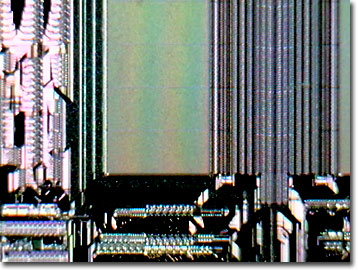Integrated Circuit Image Gallery
Picture-In-Picture Integrated Circuit
Whether screening the latest DVD cinematic release without missing the final minutes of the big game on the large-screen color television, or the members of the family are disputing which channel to switch to during those frequent commercials, the picture-in-picture function has become a mainstay for many hardcore television fanatics. Also referred to as a dual channel platform, picture-in-picture (PIP) integrated circuit technology simplifies so-called channel surfing and may offer applications in medical care, commercial video production, security monitoring, and other fields in which simultaneous monitoring of two different video signals provides an advantage to the viewer.

View a low magnification image of a pip integrated circuit.
View a medium magnification image of a pip integrated circuit.
In 1989, the Siemens Semiconductor Group designed the PIP chip for television applications as the first electronic device produced with integrated dynamic random-access memory (DRAM) embedded within the circuitry. The Siemens SDA 9188-3X video processor integrated circuit is a picture-in-picture processor with on-chip phased-loop logic. It was designed to combine two asynchronous video sources so that a small image (the inset picture) can be superimposed in a moving picture of normal size (the parent picture).
Techwell, another semiconductor manufacturer, created the TW3800 as an advanced picture-in-picture chip that is designed for medium to large screen television and monitor applications. Applying mixed-signal 3.3-volt complementary metal oxide semiconductor (CMOS) fabrication techniques, the TW3800 design provides a low-cost, low-power, and high performance integrated module for consumer electronic devices. Integrated triple-channel digital-to-analog converters, 10-bit analog-to-digital converters, embedded static RAM, and front-end video clamping are all incorporated into this miniaturized electronic device. Utilizing relatively new digital processing technology, an internal image compressor provides filtered scaling of the output picture for sub-picture insertion. The inset image can be up to 10 percent of the main picture area, and for a projection television having a 70-inch screen, an advanced single tuner picture-in-picture can translate into an inset image measuring over 7 inches diagonally.
Contributing Authors
Omar Alvarado, Thomas J. Fellers and Michael W. Davidson - National High Magnetic Field Laboratory, 1800 East Paul Dirac Dr., The Florida State University, Tallahassee, Florida, 32310.
BACK TO THE INTEGRATED CIRCUIT IMAGE GALLERY
BACK TO THE DIGITAL IMAGE GALLERIES
Questions or comments? Send us an email.
© 1995-2025 by Michael W. Davidson and The Florida State University. All Rights Reserved. No images, graphics, software, scripts, or applets may be reproduced or used in any manner without permission from the copyright holders. Use of this website means you agree to all of the Legal Terms and Conditions set forth by the owners.
This website is maintained by our
Graphics & Web Programming Team
in collaboration with Optical Microscopy at the
National High Magnetic Field Laboratory.
Last Modification Friday, Nov 13, 2015 at 01:19 PM
Access Count Since September 17, 2002: 8410
Visit the website of our partner in introductory microscopy education:
|
|
